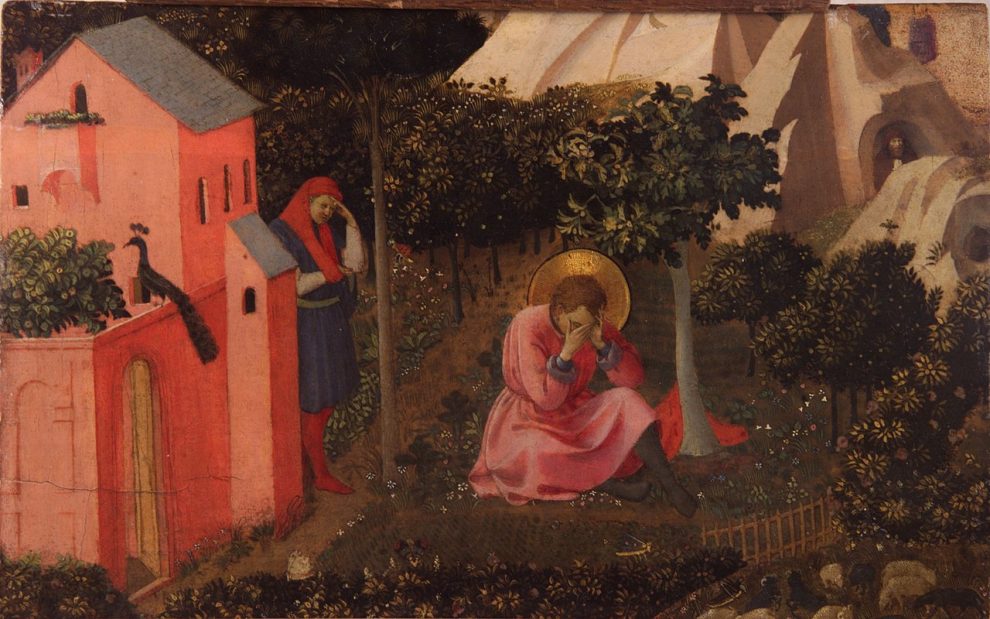Recently, I came across a portrait by teen artist Betty Shanefelter in the American University/Museum of Contemporary American Teenagers exhibit, The Teen Experience. Entitled “Falling,” the piece depicts a teenage girl in a free-fall, clawing the air with a look that is both desperate and resigned. I was moved to tears.
Perhaps it is because I am on the threshold of helping my own kids navigate their own teenage years—or because I am about to begin another semester, teaching first year college students to lean into questions about the meaning of life, and their own lives, in particular—but reflecting on the anxiety and despair these young people endure, in this chaotic world, weighs heavily on my heart.
This semester, I will be teaching Augustine’s Confessions again. While the writings of a philosopher and theologian who lived over 1500 years ago might seem irrelevant to contemporary readers, Augustine lived at a time rife with threats and challenges similar to what we face today.
Augustine, too, lived during a time when the world seemed to be crumbling. While he did not have to grapple with the reality that our planet may soon become inhospitable to human life, he did live through the fall of Rome, which must have felt similarly apocalyptic. In his time, wealth inequality exploded, military violence abounded, and emperors became increasingly authoritarian and terrorizing.
Despite the signs of collapse, the empire continued its trajectory of violence and greed. As Peter Brown puts it in his seminal biography of Augustine, “this world, on the edge of dissolution, had settled down to believe that it would last forever.” It was a confusing and morally disorienting world for a child to be born into. Augustine’s contemporary, Saint Jerome, described the experience of a child at the time with words applicable to today: “Disasters surround her as she plays.”
For Augustine, the solution to navigating times of sorrow, loss, and destruction is found in love—a love that holds space for the tenderness and vulnerability of grief, while moving us to action for justice and forging bonds of community. The community Augustine envisions is both physical and transcendent: the eternal, incarnate Body of Christ, which sustains all that is, has been, and will be.
The opening paragraph of Confessions contains the well-known line, “You have made us for yourself, and our heart is restless until it rests in you.” The last book of Confessions fills out this concept: “The place where we find rest is the rightful one for us. To it we are raised by love.…It is in goodness of will that we find our peace.”
Augustine invites us to reflect on the love that calls us to itself, bringing unique and disparate beings into one unified reality. During times of crisis, choosing to love through the suffering—even when we feel we can’t make a difference—is our only hope for peace.
Such love is transcendent, above and beyond our earthly experiences. But it is also present and embodied. This paradox helps explain why contemplation and action are two sides of the same coin. On one hand, love motivates me to do all I can to participate in the salvation of this world. On the other hand, regardless of the outcome of my actions, I know that the very act of loving carries us all through eternity.
Contemplating the eternal vision of divine unity in Christ can help ground the work of love in the demands of the present, so the eternal is manifest in every act of care. In City of God, Augustine recognizes the necessity of both action and contemplation: “It is love of truth that looks for sanctified leisure, while it is the compulsion of love that undertakes righteous engagement in affairs. . . .Yet even in this [latter] case the delight in truth should not be utterly abandoned, for fear that we should lose this enjoyment and that compulsion should overwhelm us.”
Without contemplation, which allows us to extend our vision beyond our immediate circumstances, we will never feel at peace. The transience of life ensures that. And yet, unless we act in ways that nurture that broader vision of justice, peace will remain elusive.
In this era, young people are holding the weight of our social institutions crumbling and our ecosystems fracturing. Many are understandably disillusioned about the religious traditions that helped people navigate tumultuous times in the past. It doesn’t help to hold out hope as something focused only on an afterlife—or as an exclusive perk of joining a religion. This is especially the case when that religion has often contributed to the current trends of domination and destruction.
In a recent message to Gen-Z Catholics, Pope Leo XIV encouraged young people, saying, “you will be seeds of hope where you live, in your families, among your friends, at school, at work, and in sports. You will be seeds of hope with Christ, our hope.” This kind of hope requires action; it requires us to look beyond what we can see, and work to bring to life what we hope for.
Despair is dangerous for many reasons, one being that when we give up, we stop doing this work. Compassion, by contrast, helps us find the strength to continue in the struggle and nurture the good.
As I think about how to convey this hope to young people who feel they are free-falling in this moment of chaos and despair, my sense is that love is the key. Not because love will magically solve every problem immediately, but because it frees us from the burden of worrying exclusively about outcomes. Love asks that we pour ourselves into the care of our world, without regard for what the future might hold. Love makes us strong, free to be fully ourselves—and to accept others without fear—as we participate in healing the world’s suffering.
It can be hard to endure the reality that what we hope for may not happen. But love can sustain our spirits and help us adapt, to be resilient, to hold onto our humanity.
Here’s a question: How might Shanefelter’s portrait have evoked a different response, if the falling girl had been holding the hand of another?
As I prepare to teach again, in a tumultuous time, I pray that I can impart to my students some of the hope that Augustine’s spirituality inspires in me—even when I am tempted to despair about the future.
Augustine’s words in his letter to Proba, a wealthy Christian widow who sought his advice on prayer, encourage me (gender-exclusive language notwithstanding):
He who inspired you with this thought is assuredly doing what He promised to His disciples when they were grieved, not for themselves, but for the whole human family, and were despairing of the salvation of any one, after they heard from Him that it was easier for a camel to go through the eye of a needle than for a rich man to enter into the kingdom of heaven. He gave them this marvelous and merciful reply: The things which are impossible with men are possible with God.
Making the impossible possible, I believe, is the compulsion of love. And love never fails.
Image: The Conversion of St. Augustine, Fra Angelico. Wikimedia Commons













Add comment